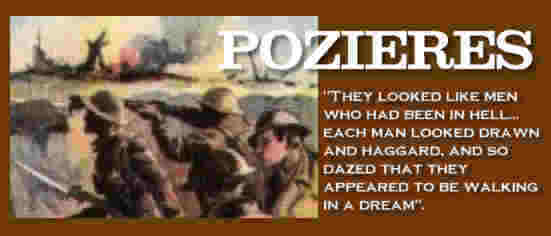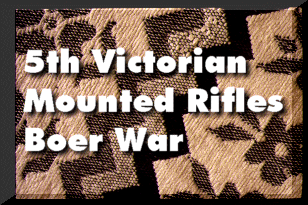THIS PAGE IS PART OF THE DEFENDING VICTORIA WEBSITE ![]()
![]()

 TURKEY
TURKEY
(25 APRIL-20 December, 1915)
The wry humour and irony of the Australian digger is well-known.
Next to ANZAC Cove at Gallipoli, and just down the coast from a point dubbed `Hell Spit' by the ANZACs (Australian and New Zealand Army Corps) lay `Brighton Beach' *-- a name that conjures up lazy summer days at the picturesque beach at Brighton, a prosperous Melbourne bayside suburb.
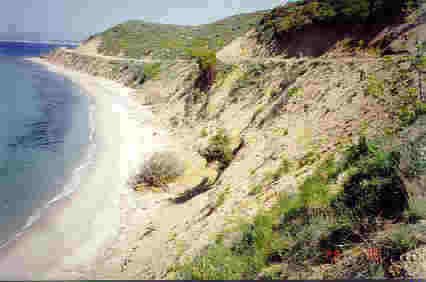
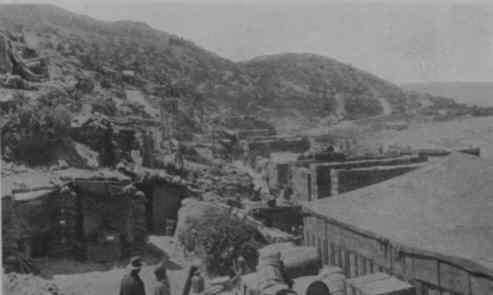
But Gallipoli had nothing in common with Brighton Beach. There were no yachts rocking at anchor, no soft sand and no girls . . .
_____________
* Most of Australia's seaport State capitals--including Perth--have a Brighton Beach, but it is likely this one was named after the one at Melbourne.
The push for an allied advance on the Turkish Capital, Istanbul, northwards to the poorly defended frontiers of southern Europe led to the allied attack on the Dardanelles of Turkey. British and French forces were sent to other Gallipoli sectors. But at ANZAC sector, Victorians played a strong, often heroic part (five VCs), in the landing and protracted campaign at Gallipoli in 1915. Warfare in craggy, rough terrain provided new challenges for artillery, infantry and the soldiers of the Light Horse now stripped of their mounts and involved in the squalid life of the trenches.

Turkish forces overlooking the ANZAC sector (the 19th Division) were commanded by Lt-Col (later Colonel) Mustafa Kemal Bey (later, the great Turkish political leader Kemal Ataturk). He was determined to oust the ANZACs at any cost. During the ANZAC landing most of the Turkish 57th Regiment was killed or wounded. In planning one of the early counter-attacks, he issued the following order:
'Every soldier who fights here with me must realize that he is in honour bound not to retreat one step. Let me remind you all that if you want to rest there may be no rest for our whole nation throughout eternity. I am sure all our comrades agree on this, and that they will show no signs of fatigue until the enemy is finally hurled into the sea'.
During several of the ensuing battles, the Turkish position became precarious and victory could have gone either way. Colonel Mustafa Kemal felt that British commanders were irresolute and that his men were more 'resistant' than British and ANZAC troops. Even so, Turkish casualties during several battles were so severe as to curtail further large scale counter-attacks for a time. The worst thing about the ANZAC sector battlefield, Colonel Kemal felt, was the constant smell of rotting corpses in exposed areas which could not be recovered and buried without further casualties.
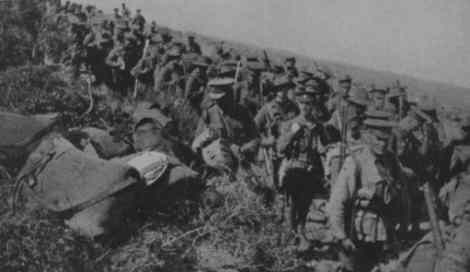
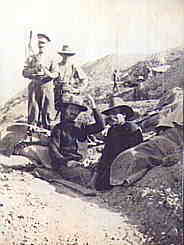 .William Clark and mates at Gallipoli.
.William Clark and mates at Gallipoli.|
|
ANZAC INGENUITY--THE PERISCOPE RIFLE
The Australian soldier had, even during the earlier Anglo-Boer War, earned a reputation for ingenuity and improvisation. One example of this at Gallipoli was the invention in May 1915 of the periscope rifle by L/Cpl. Beech of Sydney. Mirrors allowed the user to sight the rifle while completely invisible to the enemy. The rifle was accurate up to 300 metres (sometimes the opposing trenches were only metres apart). The idea was quickly adopted by the Turks.
MAP (in Turkish) of the Gallipoli battlefields by Mustafa Senocak <---Click here
Turkish soldiers on Suvla Plain (Photo provided by Mustafa Senocak) <---Click
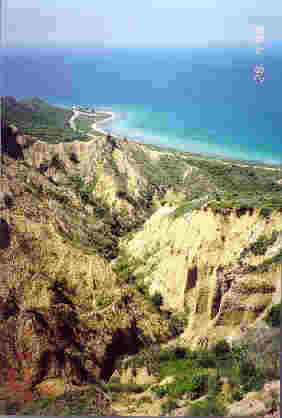
An Australian submarine AE2 was sunk in the Straights. Onshore actions at `The Nek' , Lone Pine, Courtny's Post (there were ten thousand Turkish casualties here), among others, held the numerically stronger Turkish defenders at bay.
|
Total casualties of the Gallipoli Campaign
|
![]()
A Turkish visitor, Mustafa Senocak, is designing a Gallipoli website (which will be linked here when completed) and has provided his map of the ANZAC Sector in Turkish. Australian and Turkish positions are shown as abbreviations:
DÇ : Damakçıl Bayırı ( Damakjelik Bair) AB : Abdurrahman Bayırı (Abdel Rahman Bair) Ç : Çiftlik (The farm) DT : Düztepe (Battleship Hill) B : Boyun (The Neck) MT : Merkeztepe (German Officer's trench) MG : Malone's gully CT : Cesarettepe (Walker's Ridge) S : Sfenks (The Sphinx) TÇ : Tekçam ( Lone pine) HT : Haintepe (Plugge's plateau) ŞD : Şarapneldere (Shrapnel Valley) HS : Hell Spit JJ : Johnstons's Jolly MV : Monach vadisi ( valley) McKT : Mc Kay tepesi (hill) PR : Pine ridge LV : Legge vadisi ( valley) RT : Russell's Top MR : Mortar's ridge VD : Valley of Despair KB : Kılıçbayırı ( Baby 700) BS : Bombasırtı (Quinn's post) QP : Queensland Point 400RT : 400 rakımlı tepe CN : Chatham point.
ARIBURNU SAVAŞLARI BÖLGESİ - ANZAC SECTOR MAP <--- CLICK.
The same ANZAC SECTOR map in English <---Click. Note: the map is high resolution and may take 10 seconds to load.
![]()
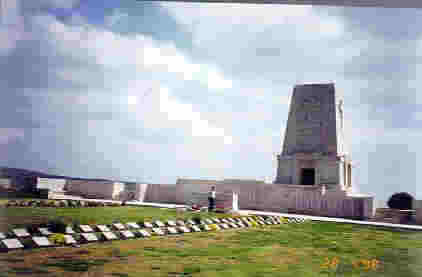
|
|
In some ways the most tragic of these operations was the attack on `the Nek' on 7 August 1915 by dismounted Light Horsemen of the 3rd Brigade. They were ordered to charge uphill in four successive waves of 150 men. A British naval bombardment unexpectedly stopped seven minutes early -- enough time for the Turkish forces to re-occupy their trenches. Each line of Light Horsemen was slaughtered as it emerged from the Australian trenches. At the same time nearby, the Light Horsemen of the 1st Brigade were being being cut down as they charged from Quinn's and Pipe's Post. Hundreds died bravely in half-an-hour. Their heroic sacrifice at The Nek had gained not one yard. This tragic action was recreated and remembered in the recent movie 'Gallipoli'.
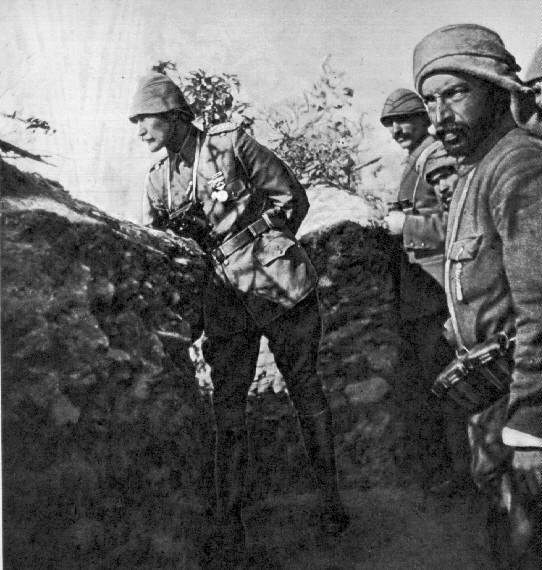
|
|
In what became one of the classic withdrawals in military history, the ANZACs (and other allied forces elsewhere) were taken off Gallipoli. The ANZACs left over three nights (18-20 December 1915) without a single loss. A Victorian VC winner from the Boer War, Leslie Maygar, was in charge of the last 40 men left in the trenches until they too withdrew. The ANZAC trenches were empty when curious Turkish forces investigated. Because the battlefield by then had become static, with none of the tragic charges and counter-attacks taking place any longer, Colonel Kemal had already left for Constantinople (Istanbul) ten days earlier, and did not experience the final elation of the Turkish victory.
HOW THE WITHDRAWAL WAS ACCOMPLISHED
In addition to meticulous planning among allied commanders, ordinary soldiers contributed ingenuity to the various ruses that would cover the withdrawal. Among these were two versions of a self-firing rifle. These were devised by Australians to give the impression that the ANZAC trenches were still occupied even after the troops had departed. One version used two tins. One with a small hole was filled with water which dripped into the other tin. When full, the second tin fell over and fired the rifle by tugging on a string attached to the trigger. The second version involved a candle burning through rope, which then dropped a weight and fired the rifle.
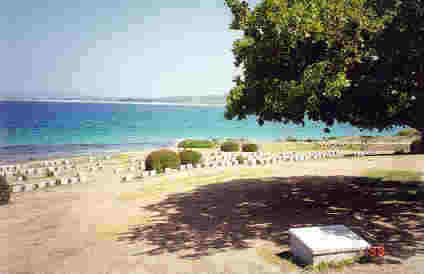
Beach Cemetery, near Anzac Cove. 1998 photo by Bridget and Paul Roser.
One of the saddest aspects of the Gallipoli campaign is contained in the book 'To What End did They Die?' by R. W. Walker which lists the British and ANZAC officers who died there. Most of the entries contain the phrase 'No known grave'. . .
Gallipoli survivors who then went to the Western Front in Southern Belgium and Northern France discovered that the hell of Gallipoli was only a prelude to an unprecedented human bloodbath amidst clinging mud moonscapes; poison gas; horrendous, unending artillery barrages; barbed wire, sodden uniforms and the likely possibility of immediate death. Even recently, the bones of unknown soldiers are still being discovered in French and Belgian fields.
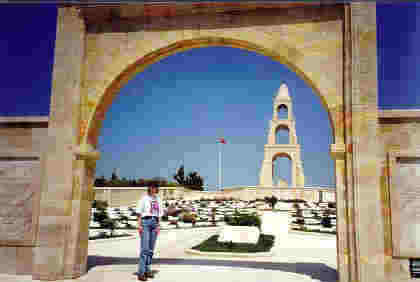
Turkish memorial and cemetery, and Bridget Roser. 1998 photo by Paul Roser.
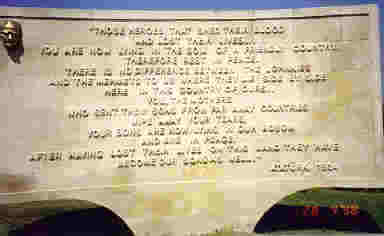
|
|
PHOTOS, LETTERS & DIARIES NEEDED


Recommended Gallipoli Campaign site -- (external link)
Site for people/divers interested in warships/transports sunk off Gallipoli (Turkish site)
Another website from the same source as above -- underwater tours (Turkish site)
